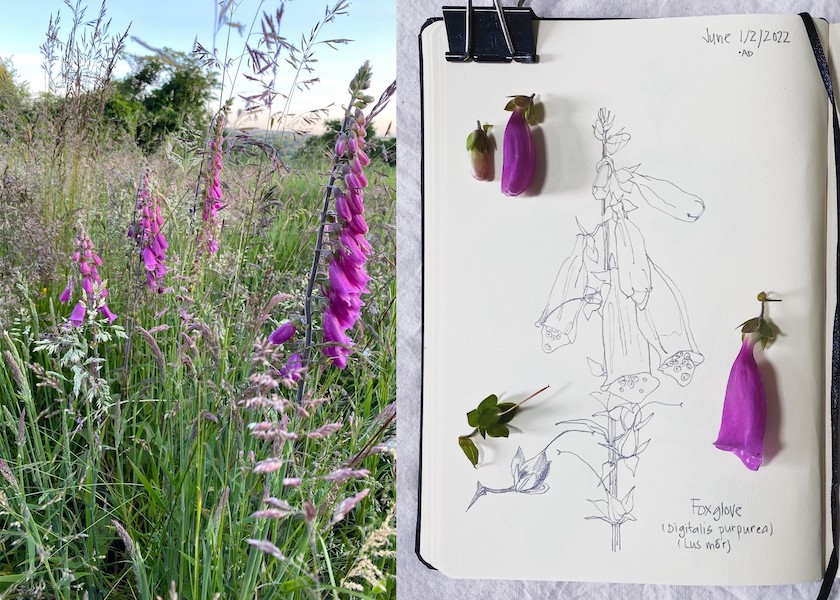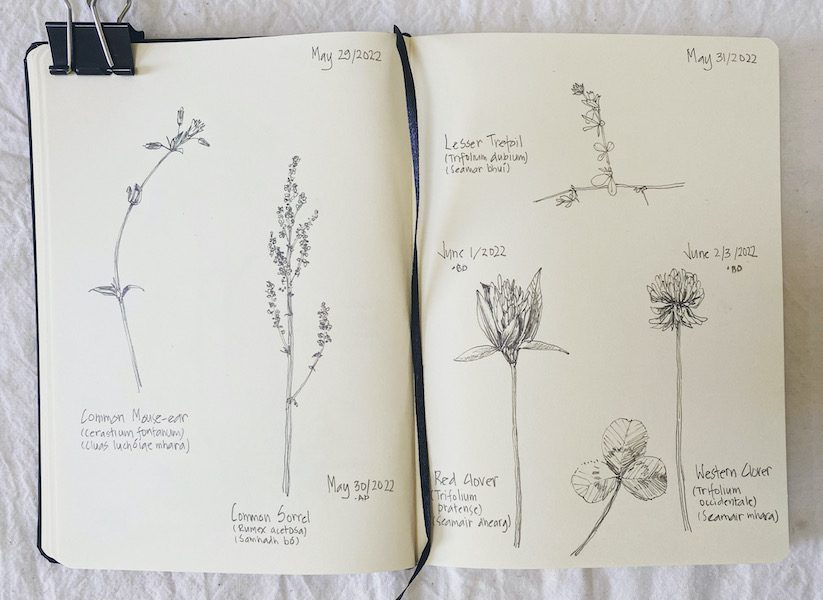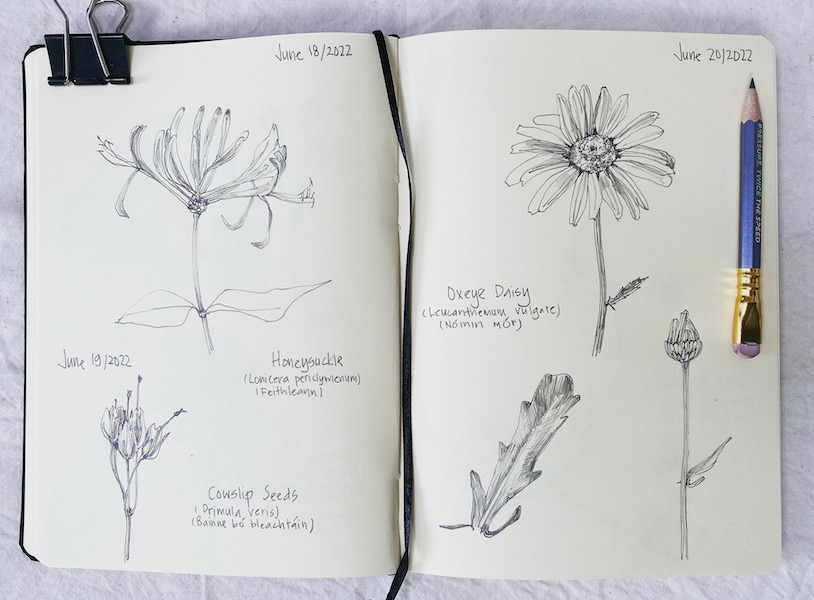an Spéir ARK | Biodiversity Diary
My name is Jennie Castle. I am delighted to have been invited by Ashleigh Downey to participate in the Greenhouse Culture TAKEOVER for the month of June 2023! I will be sharing the ‘an Spéir ARK’ re-wilding project, my eco-arts practice, and the weekly drawings of the month of June 2022, from my Biodiversity Diary with you.
My first connection with Ashleigh was through the Wild Acres Project which was hosted online by Green Sod Ireland in August 2022. Ashleigh was presenting her talk ‘The Art of Fieldnotes’. It was an inspiring talk, and I could see so many parallels and connections in the work I was doing. And then I realised that all things are connected and started to see the webs of connections between people, their projects and the natural world that surrounds us. So, here is my journey of connections: land, ecology, art, and inspiring environmentalists……
Background
My years of architectural training and fine art study feel like a lifetime away! Over the last decade, my practice in Ireland has become art and ecology focussed and I have finally found descriptions which I feel reflect my work and passion for the environment. These being ‘Eco-artist’ and ‘ARKitect’. My artwork is focussed on native plants and their immediate environment, and I am using my artwork to promote and celebrate biodiversity in a time of climate crisis. The term ‘ARKitect’ comes from the latest book by nature activist, Mary Reynolds. For those of you who have yet to discover the environmental movement established by Mary Reynolds, I am delighted to introduce to you ‘We are the ARK’ – Acts of Restorative Kindness to the Earth. Mary’s work has been the inspiration, and given direction, for the creation of ‘an Spéir ARK’, a project to re-wild 3 acres of rural land in County Kilkenny. The word ‘an Spéir’ in Irish, means ‘the Sky’.
Another inspiration for me has been the publication ‘Wilding’ by Isabella Tree. I listened to it as an audio book, read by the author. It maps out the journey of ‘letting nature take the driving seat’ and the re-wilding of 350 acres of land at Knepp Estate in the South of England.
Here in Ireland, 3 acres make up ‘an Spéir ARK’, and the land has been under the stewardship of my husband and myself. We undertook to re-wild the land once our family dwelling was completed in 2015. When we started as the guardians of the land, it was divided up into 3 main fields separated by typical stonewalls and hedgerows and had been grazed by sheep over several decades. It was a green desert, devoid of plant and animal life, with the hedgerows shorn vertical. Once the sheep were removed, the magic began.
We walked the land each day creating ‘desire paths’ – our own natural paths, mainly around the perimeters of the fields, and some following those of the foxes who inhabit the hedgerow thickets. Later we kept these paths mown and maintained to give access to the land. The paths branch off into resting or sitting spots in the corners of the fields. The movement through the land and viewing of it from different heights allows for a variety of engagement and experiences.
The land is divided roughly into 3 main areas, each with a different character: The Grass Meadow, in the Southeast field, the New Forest in the Southwest Field and the Wildflower Meadow on the upper field in the West.

Once the access paths and sitting areas were in place we started to watch, observe, and then to document the transformation. Here is a small reel showing 3 aerial photos from 2013, 2019 and 2022 illustrating the changes in the land.

The Grass Meadow
The trees and bushes in the hedgerows, the Whitethorn, Blackthorn and Elder, as if freed from bondage, started spreading their branches. The Blackthorn took off, sending its underground suckers into the field and sprouting as small trees, forming a new layer to the hedgerow. Brambles in the hedgerow started throwing meter long projectiles of new prickly shoots into the field, these taking root as they made contact with the ground. These have now formed thickets at the base of the hedgerows and areas of bramble cages. One of the functions of these cages is to provide protection from grazing animals for the new forest trees to emerge. The appearance of small oak saplings is evidence of the presence of the work of Jays who plant the acorns for food. At the same time as the spread of the Brambles, came the advance of the Bracken into the field, moving about a half a meter per year. A rich diversity of plants has started to appear in the grasses in the meadow: mainly Buttercups, Yarrow, Speedwell, Cows Parsley, Spear Thistle, Creeping Thistle, and Sow Thistle. In late Summer the grass meadow comes alive with Meadow Brown butterflies as you move along the paths. We added a small nuttery and wild fruit orchard by planting Hazel and Wild Cherry in the hope of attracting the native red squirrel to the land. A fiery yellow ball of sweet-smelling Gorse has self-seeded close to the nuttery, and it usually covered in insects.

The New Forest
We helped kickstart the process of recovery in 2016 by adding, 120 small native tree saplings, (about 60cm high) such as the Oak, Silver Birch, Alder, Elder, Holly, Hazel, Rowan and Scots Pine to the Southwest field. While the digger was on site for the tree planting, we scooped out an area as a small wildlife pond and wetland area. Within the first day of filling up a small rock pond, the dragonfly arrived. Each late January to early February, the pond is afloat with mounds of wobbly frog spawn.
Once the small saplings were planted, the Dock appeared in abundance, growing to the height of the saplings, giving the appearance of a densely populated mini forest. The other pioneer species which appeared was the Willow. It has dispersed randomly amongst the new trees helping to create an instant forest. As the new trees started to establish themselves and form a bit of a canopy, so the grass started to recede under the trees, and brambles started appearing. Creeping Thistle was the next to native to compete with the Grasses and the Dock, its sea of tufty, flowers creating a purple pantry for insects and butterflies. The Dock is no longer centre-stage and grassy areas are now beginning to diversify with mixes of Speedwell, Buttercup, Yarrow, Vetches, Ribwort Plantain and the first appearance of the Cuckoo flower. The bird life has increased ten-fold with a deafening drawn chorus at the beginning of May. The criss-cross of fox desire paths across the land indicates the increased numbers as well as the Mid-Summer appearances of cubs eating strawberries in the veggie patch!


(Photograph by Dayle Hacking)
The Wildflower Meadow
An open, level area of grass, close to the dwelling on the Northwest side and sloping down to the New Forest, we have called the Wildflower Meadow. We have managed this section of the land by cutting down small areas the existing grass, close to the ground, to encourage new species to come up and attempted to suppress the dominant grass by layering cardboard covered with topsoil. Into these areas and small pockets within the meadow, we have sprinkled wild seeds gathered from the land and transplanted Foxglove, Rosebay Willowherb and Teasle seedlings which had self-seeded around the land.

The re-wilding project so far has been a thrilling experience and so hopeful, to know that the land is waiting to recover and will do so at a relatively rapid rate. Whatever piece of earth or land you have, small or large, let it go, let it be freed of human bondage and to become a sanctuary for native plants and wildlife.
The Eco-Artwork
Once I had a studio space set up in the old stone dwelling which was restored in 2013, I had begun documenting the plants on the land and sharing the work on my website and social media and through annual open studio exhibitions. The first ‘Re-Wilding’ exhibition took place in 2019 and the themes changes each year from native flowers to Butterflies and their host food plants, to the Bramble and, coming up this year, is the Fern and Bracken. The open studio exhibition forms part of the annual, local art festivals in County Kilkenny. These are TCAF (Thomastown Creative Arts Festival) and AKA (Alternative Kilkenny Arts).
It was in the beginning of 2022, that the Biodiversity Diary | ‘Keep it Wild’ project evolved with a few coinciding prompts! These were a blank drawing book as a gift, a Christmas card with the words ‘Keep it Wild’ scribbled across the top in the hand of Mary White of Blackstairs Eco Trails and a New Year’s post on Instagram by a friend, of an open blank book and the words ‘How will you fill these pages this year?’. With these catalysts, the journey of a drawing a day began with daily walks – in all weather! – to collect plants. As the time went on, my awareness of the seasonal changes, and the plant changes, increased as did my attachment to the land. As most artists will know – to draw is to connect at a deeper level. I have included 6 pages of drawings using a soft no. 602 Blackwing pencil, from the month of June for you. My favourite being June 26 – 30: The Field Rose | Rosa arvensis | Rós Léana and the Bramble | Rubus fructicosus | Dris and the drawing for Mid-Summer’s Day too: the Crab Apple | Malus sylvestris | Crann fia úll.
I would encourage everyone to keep a notebook – you never know where it will lead you!
A quote by Jack London from Ashleigh’s talk: ‘The Art of Notebooks’
‘KEEP A NOTEBOOK. Travel with, eat with it, sleep with it. Slap into it every stray thought that flutters up into your brain. Cheap paper is less perishable than gray matter, and lead pencil markings endure longer than memories.’
Pages from the Biodiversity Diary | ‘Keep it Wild’ 2022

| JUNE 1 | Red Clover | Trifolium pratense | Seamair dhearg |
| 2 | Western Clover | Trifolium occidentale | Seamair mhara |
| 3 | Western Clover | Trifolium occidentale | Seamair mhara |

| 4 | Yarrow | millefolium | Athair thalún |
| 5 | Spear Thistle | Cirsium Vulgare | Feochadán colgach |
| 6 | Ragged-Robin | Silene flos-cuculi | Lus síoda |
| 7 | Ragged-Robin | Silene flos-cuculi | Lus síoda |
| 8 | Salad Burnet | Sanguisorba minor | Lus an uille |
| 9 | Salad Burnet | Sanguisorba minor | Lus an uille |

| 10 | Musk Mallow * | Malva moschata | Hocus muscach |
| 11 | Common Knapweed | Centaurea nigra | Mínscoth |
| 12 | Elder | Sambucus nigra | Trom |
| 13 | Elder | Sambucus nigra | Trom |
*Non-native

| 14 | Field Rose | Rosa Avensis | Rós Léana |
| 15 | Dog Rose | Rosa canina | Feirdhris |
| 16 | Field Forget-me-not | Myosotis arvensis | Lus míonla goirt |
| 17 | Common Poppy* | Papaver rhoeas | Cailleach dhearg |

| 18 | Honeysuckle | Lonicera periclymenum | Feithleann |
| 19 | Cowslip | Primula veris | Bainne bó bleachtáin |
| 20 | Oxeye Daisy | Leucanthemum vulgare | Nóinin mór |
| 21 | Oxeye Daisy | Leucanthemum vulgare | Nóinin mór |

| 22 | Wild Strawberry | Fragaria vesca | Sú talún fiáin |
| 23 | Wild Strawberry | Fragaria vesca | Sú talún fiáin |
| 24 | Crab Apple | Malus sylvestris | Crann fia úll |
| 25 | Blackthorn | Prunus spinosa | Draighean |

| 26 | Field-rose | Rosa arvensis | Rós Léana |
| 27 | Field-rose | Rosa arvensis | Rós Léana |
| 28 | Bramble | Rubus fructicosus | Dris |
| 29 | Bramble | Rubus fructicosus | Dris |
| 30 | Bramble | Rubus fructicosus | Dris |
June 2022
| 1 | Red Clover | Trifolium pratense | Seamair dhearg |
| 2 | Western Clover | Trifolium occidentale | Seamair mhara |
| 3 | Western Clover | Trifolium occidentale | Seamair mhara |
| 4 | Yarrow | millefolium | Athair thalún |
| 5 | Spear Thistle | Cirsium Vulgare | Feochadán colgach |
| 6 | Ragged-Robin | Silene flos-cuculi | Lus síoda |
| 7 | Ragged-Robin | Silene flos-cuculi | Lus síoda |
| 8 | Salad Burnet | Sanguisorba minor | Lus an uille |
| 9 | Salad Burnet | Sanguisorba minor | Lus an uille |
| 10 | Musk Mallow * | Malva moschata | Hocus muscach |
| 11 | Common Knapweed | Centaurea nigra | Mínscoth |
| 12 | Elder | Sambucus nigra | Trom |
| 13 | Elder | Sambucus nigra | Trom |
| 14 | Field Rose | Rosa Avensis | Rós Léana |
| 15 | Dog Rose | Rosa canina | Feirdhris |
| 16 | Field Forget-me-not | Myosotis arvensis | Lus míonla goirt |
| 17 | Common Poppy* | Papaver rhoeas | Cailleach dhearg |
| 18 | Honeysuckle | Lonicera periclymenum | Feithleann |
| 19 | Cowslip | Primula veris | Bainne bó bleachtáin |
| 20 | Oxeye Daisy | Leucanthemum vulgare | Nóinin mór |
| 21 | Oxeye Daisy | Leucanthemum vulgare | Nóinin mór |
| 22 | Wild Strawberry | Fragaria vesca | Sú talún fiáin |
| 23 | Wild Strawberry | Fragaria vesca | Sú talún fiáin |
| 24 | Crab Apple | Malus sylvestris | Crann fia úll |
| 25 | Blackthorn | Prunus spinosa | Draighean |
| 26 | Field-rose | Rosa arvensis | Rós Léana |
| 27 | Field-rose | Rosa arvensis | Rós Léana |
| 28 | Bramble | Rubus fructicosus | Dris |
| 29 | Bramble | Rubus fructicosus | Dris |
| 30 | Bramble | Rubus fructicosus | Dris |
TAKEOVER by ECO-artist/ARKitect | Jennie Castle Artist
Artist Biography
Jenette Perree Castle
Jennie Castle is a Zimbabwean born, Irish artist working from her studio in rural County Kilkenny. She received both Bachelor’s and Master’s degrees in Architecture from the University of Kwa-Zulu Natal, in South Africa, in 1987 and has a background in Fine Art. Jennie has pursued a creative path throughout her architectural career in South Africa and since arriving in Ireland in 2006, established her own studio space. Jennie has worked in multiple media, from mosaics, ceramics, printmaking to drawing and oil painting to express her interest in the natural and built heritage of her immediate environment.
Jennie has facilitated both mosaic workshops and community mosaic projects within the County. The artist assisted in establishing local community projects: Thomastown Community Network, Thomastown Creative Arts Festival and Thomastown Biodiversity Garden. Jennie is currently involved in a community-led housing project (Nimble Spaces) in Callan, County Kilkenny.
A solo exhibition in Berlin: ‘Exotica Noir’ in 2010 and the design and supervision of a passive house in 2015, with the establishment of a rewilding project on the land, have been recent career highlights. At a time of climate crisis and biodiversity loss, the land project has provided an ecological focus to the artist’s work. Jennie has curated open studio exhibitions around the theme of rewilding as part of the arts festivals: Alternate Kilkenny Arts and Thomastown Creative Arts Festival. In 2022, Jennie completed a daily drawing diary documenting the plant biodiversity of the land. A recent publication in the Irish Sunday Independent attracted considerable on-line response. Jennie is currently developing her ecological arts practice.
www.jenniecastleartist.com www.instagram.com/jenniecastleartist


